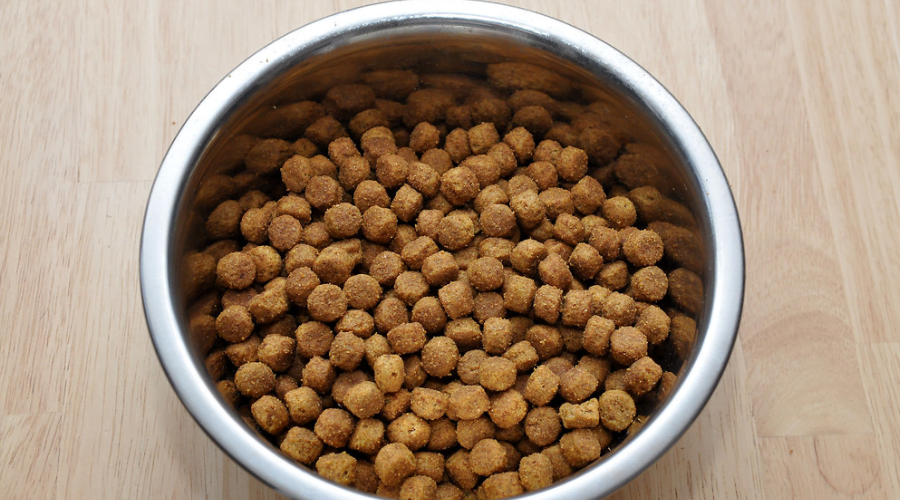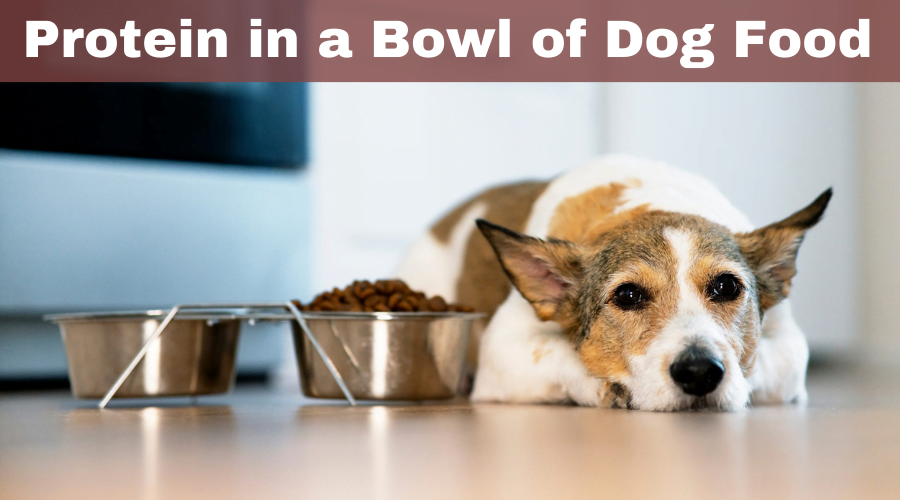Introduction
Protein is an essential nutrient for dogs, playing a crucial role in their overall health and well-being. It is vital for muscle mass growth, development, and maintenance. Understanding the importance of protein in your dog’s diet is critical to providing them with the nutrition they need to thrive. In this article, we will explore the role of protein in a dog’s growth and development, how much protein they need, the different types of protein sources in dog food, how to choose the right protein-rich dog food, the benefits and risks of high-protein dog food, how to calculate the protein content in your dog’s food, the best protein supplements for dogs, and frequently asked questions about protein in dog food.
Understanding the Importance of Protein in Your Dog’s Diet
Protein is made up of amino acids which are the building blocks of life. It is essential for dogs as it helps build and repair tissues, supports the immune system, and aids in producing enzymes and hormones. Protein also provides energy for dogs, although it is not their primary energy source like carbohydrates and fats.
Protein plays a crucial role in a dog’s overall health and well-being. It is necessary for the growth and development of puppies as it supports the formation of new tissues and organs. It also helps maintain muscle mass and strength in adult dogs which is essential for mobility and overall fitness. Protein becomes even more critical in senior dogs as it helps slow down muscle loss and supports healthy aging.
The Role of Protein in Your Dog’s Growth and Development
Protein is vital for puppies as they go through a rapid growth phase. Their bodies develop quickly during this time, requiring more protein to support this growth. Protein helps build strong bones, muscles, and organs in puppies, ensuring they grow into healthy adult dogs.
In adult dogs, protein is essential for maintaining muscle mass and strength. Dogs that are active or participate in sports or other physical activities require even more protein to support their increased energy needs. Protein also aids in the repair of muscle tissues after exercise, helping dogs recover faster and reducing the risk of injury.
In senior dogs, protein becomes crucial for maintaining muscle mass and supporting healthy aging. As dogs age, they lose muscle mass, decreasing mobility and overall fitness. Providing them with a protein-rich diet can help slow down this muscle loss and keep them active and healthy in their golden years.
How Much Protein Does Your Dog Need?
The amount of protein your dog needs depends on various factors, including age, weight, and activity level. Puppies require more protein than adult dogs, while seniors may need slightly less. Active dogs or those participating in sports or other physical activities may also require more protein to support their increased energy needs.
As a general guideline, puppies should consume a diet that contains around 25-30% protein, while adult dogs should have a diet with approximately 18-25% protein. Senior dogs may benefit from a slightly lower protein content of around 15-20%. However, it is essential to note that these are just general guidelines, and individual dogs may have different protein requirements.
To determine if your dog is getting enough protein in their diet, you can look at their overall health and well-being. A dog getting enough protein will have a healthy coat, strong muscles, and good energy levels. If you notice any signs of malnutrition or muscle loss, it may indicate that your dog is not getting enough protein, and you should consult with your veterinarian.

The Different Types of Protein Sources in Dog Food
Protein in dog food can come from various sources, including animal- and plant-based proteins. Animal-based proteins are considered higher quality as they contain all the essential amino acids that dogs need. Familiar animal-based protein sources in dog food include chicken, beef, fish, and eggs.
On the other hand, plant-based proteins may not contain all the essential amino acids and may need to be combined with other protein sources to provide a complete and balanced diet. Familiar plant-based protein sources in dog food include soy, peas, lentils, and quinoa. While plant-based proteins can be a good option for dogs with specific dietary restrictions or allergies, ensuring they get all the essential amino acids they need is crucial.
Both animal-based and plant-based proteins have their pros and cons. Animal-based proteins are generally more easily digestible for dogs and provide a complete source of essential amino acids. However, they can be more expensive and unsuitable for dogs with specific dietary restrictions or allergies. Plant-based proteins can be more affordable and ideal for dogs with dietary restrictions or allergies. However, they may not provide all the essential amino acids and must be combined with other protein sources.
How to Choose the Right Protein-Rich Dog Food for Your Pet
When choosing a protein-rich dog food for your pet, it is essential to consider their needs and preferences. Here are some tips to help you select a high-quality dog food that is rich in protein:
1. Read the ingredient list: Look for a portion of dog food with a high-quality animal-based protein source as the first ingredient. This ensures that your dog gets enough protein from a reliable source.
2. Consider your dog’s dietary restrictions or allergies: If your dog has specific dietary restrictions or allergies, choose a food formulated to meet their needs. Many options are available for dogs with food sensitivities or allergies, including limited-ingredient diets or novel protein sources.
3. Look for a complete and balanced diet: Ensure that the dog food you choose provides a complete and balanced diet for your pet. It contains all their essential nutrients, including protein, carbohydrates, fats, vitamins, and minerals.
4. Consider your dog’s age and activity level: Consider your dog’s age and activity level when selecting a protein-rich dog food. Puppies and active dogs may require more protein to support their growth and energy needs.
5. Consult with your veterinarian: If you need clarification on which dog food is best for your pet, consult your veterinarian. They can provide personalized recommendations based on your dog’s needs and health condition.
The Benefits of High-Protein Dog Food for Active Dogs
High-protein dog food can benefit highly active dogs participating in sports or other physical activities. Here are some of the potential benefits:
1. Increased energy: High-protein dog food gives dogs the power to fuel their active lifestyle. Protein is a more efficient energy source than carbohydrates and fats, making it ideal for dogs that require sustained energy throughout the day.
2. Muscle development and repair: Protein is essential for building and repairing muscle tissues. Active dogs often put a lot of strain on their muscles, and a high-protein diet can help support muscle development and repair, reducing the risk of injury.
3. Faster recovery: Dogs need time to recover and repair their muscles after intense exercise or physical activity. High-protein dog food can aid recovery by providing nutrients to improve damaged tissues and reduce inflammation.
4. Weight management: High-protein dog food can help dogs maintain a healthy weight by promoting lean muscle mass and reducing fat storage. Protein has a higher thermic effect than carbohydrates and fats, requiring more energy to digest and metabolize. This can help dogs burn more calories and maintain a healthy weight.
While high-protein dog food can provide several benefits for active dogs, it is essential to note that it may not be suitable for all dogs. Less active dogs or those with certain health conditions may not require as much protein and may benefit from a different type of diet. It is always best to consult your veterinarian before changing your dog’s diet.
The Risks of Overfeeding Your Dog with Protein
While protein is essential for dogs, overfeeding them can have potential risks. Here are some of the risks associated with overfeeding your dog with protein:
1. Weight gain: Protein is more calorie-dense than carbohydrates and fats. Feeding your dog too much protein without considering their overall calorie intake can lead to weight gain. This is especially true for less active dogs or those with a slower metabolism.
2. Kidney damage: Dogs with pre-existing kidney conditions or those prone to kidney problems may be at risk of developing kidney damage if they are overfed with protein. The kidneys filter waste products from the blood, including the by-products of protein metabolism. Feeding excessive amounts of protein can strain the kidneys and potentially worsen existing kidney conditions.
3. Digestive issues: Feeding your dog too much protein can lead to digestive problems such as diarrhea or upset stomach. Dogs cannot digest and metabolize large amounts of protein, and overfeeding them can overwhelm their digestive system.
To avoid overfeeding your dog with protein, following the recommended daily protein intake guidelines for your dog’s age, weight, and activity level is essential. If you still determine how much protein your dog needs, consult your veterinarian for personalized recommendations.
How to Calculate the Protein Content in Your Dog’s Food
To ensure that your dog is getting the right amount of protein in their diet, you can calculate the protein content of their food using the guaranteed analysis on the dog food label. The guaranteed analysis provides information about the dog food’s minimum amount of protein, fat, fiber, and moisture.
To calculate the protein content, you must look for the crude protein percentage in the guaranteed analysis. This percentage represents the minimum amount of protein in the dog food. For example, if the crude protein percentage is 25%, the dog food contains at least 25% protein.
To determine the actual amount of protein in a serving of dog food, you can use the following formula:
Protein content (g) = Crude protein percentage (%) x Weight of serving (g)
For example, if you have a serving of dog food that weighs 100g and has a crude protein percentage of 25%, the protein content would be:
Protein content (g) = 25% x 100g = 25g
Calculating the protein content of your dog’s food ensures they get the right amount of protein in their diet.
The Best Protein Supplements for Dogs
Protein supplements can be a valuable addition to your dog’s diet, especially if they have specific dietary needs or require additional protein for their active lifestyle. Here are some of the different types of protein supplements available for dogs:
1. Protein powders:
Protein powders are a convenient way to add extra protein to your dog’s diet. They can be mixed with water or added to their regular food. Look for high-quality protein powders that are specifically formulated for dogs and do not contain any artificial additives or fillers.
2. Protein chews:
Protein chews are a tasty and nutritious dog treat. They come in various flavors and can be a good option for dogs that enjoy chewing. Look for protein chews made from high-quality animal-based protein sources that contain no artificial additives or fillers.
3. Protein treats:
Protein treats are another option for adding extra protein to your dog’s diet. They come in various forms, including jerky, biscuits, and bars. Look for protein treats made from high-quality animal-based protein sources that contain no artificial additives or fillers.
When choosing a protein supplement for your dog, it is essential to consider their needs and preferences. Consult your veterinarian for personalized recommendations based on your dog’s needs and health condition.
Frequently Asked Questions About Protein in Dog Food
1. how much protein is in a bowl of dog food?
While dogs require a certain amount of protein, too much protein can have potential risks. Following the recommended daily protein intake guidelines for your dog’s age, weight, and activity level is essential. Consult with your veterinarian for personalized recommendations.
2. Can dogs be allergic to certain types of protein?
Yes, dogs can be allergic to certain types of protein. Common allergenic proteins for dogs include beef, chicken, dairy, and wheat. If you suspect your dog has a food allergy, consult your veterinarian for proper diagnosis and guidance.
3. Can dogs be vegetarian or vegan?
While dogs are omnivores and can technically survive on a vegetarian or vegan diet, ensuring they get all the essential nutrients they need is important. Dogs require specific nutrients in animal-based products, such as vitamin B12 and certain amino acids. Consult your veterinarian before putting your dog on a vegetarian or vegan diet.
4. Can dogs eat raw meat for protein?
Raw meat can be a source of protein for dogs, but it is essential to handle raw meat safely to avoid the risk of bacterial contamination. Please consult your veterinarian before feeding your dog a raw meat diet to ensure they get a balanced and complete diet.
Conclusion
how much protein is in a bowl of dog food is an essential nutrient for dogs, playing a crucial role in their growth, development, and overall health. It is necessary to understand the importance of protein in your dog’s diet and ensure they get enough protein to thrive. By choosing a high-quality food rich in protein, considering your dog’s needs and preferences, and consulting with your veterinarian, you can provide your dog with the nutrition they need to live a healthy and happy life.

